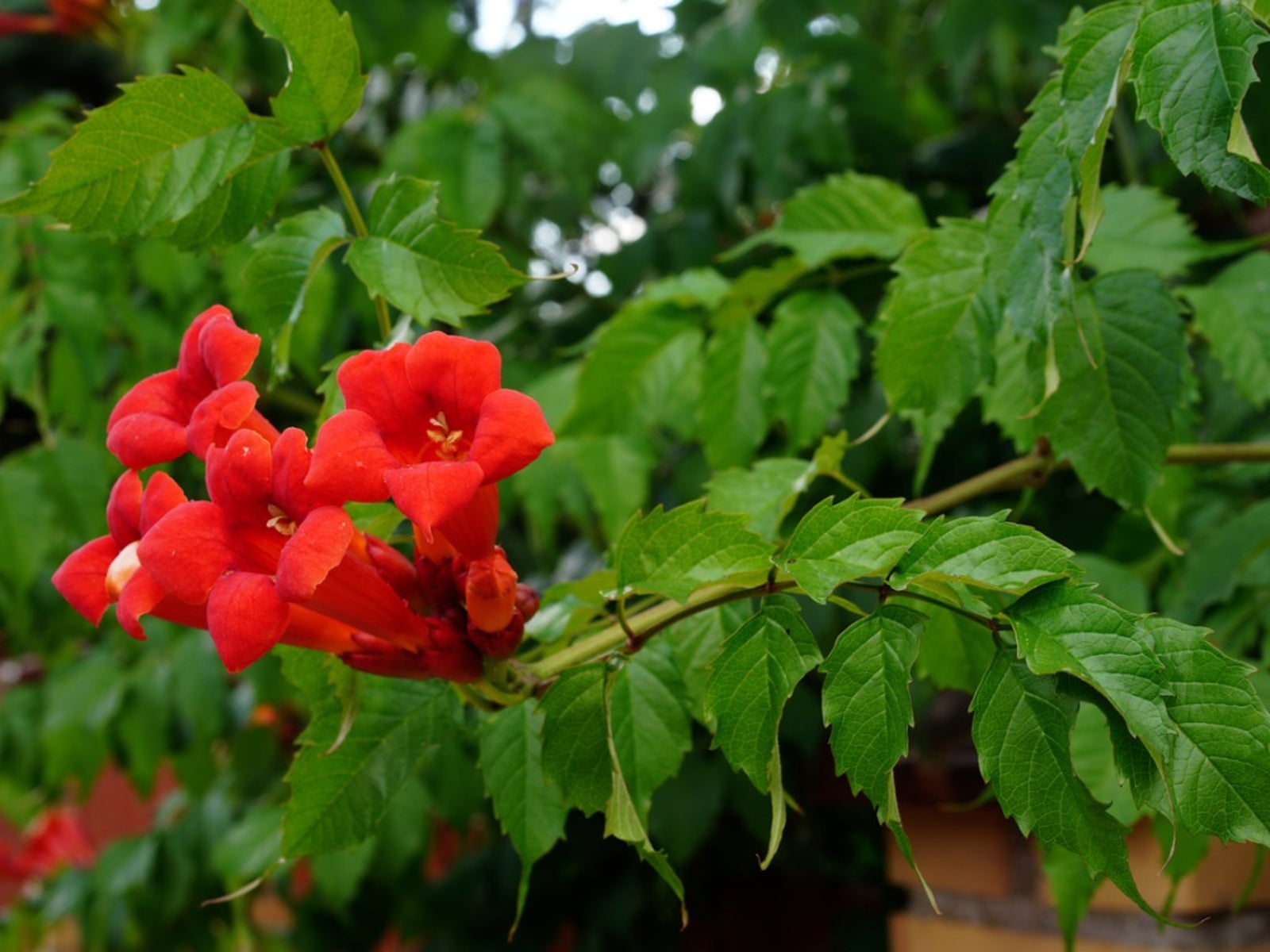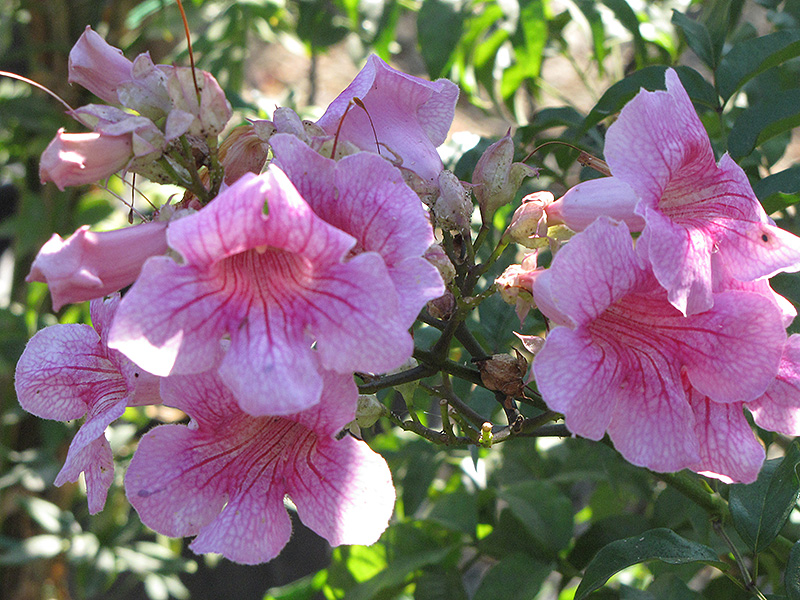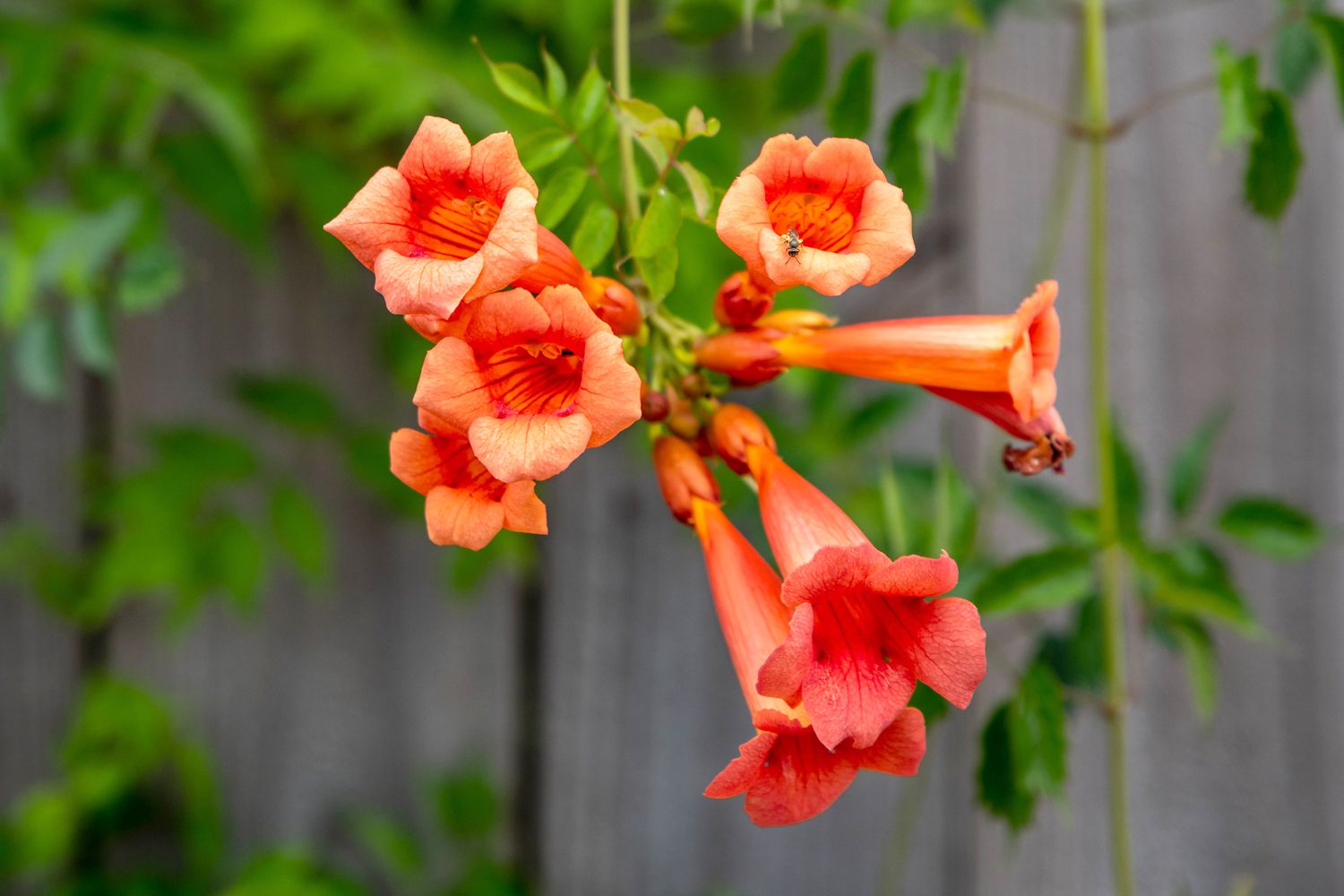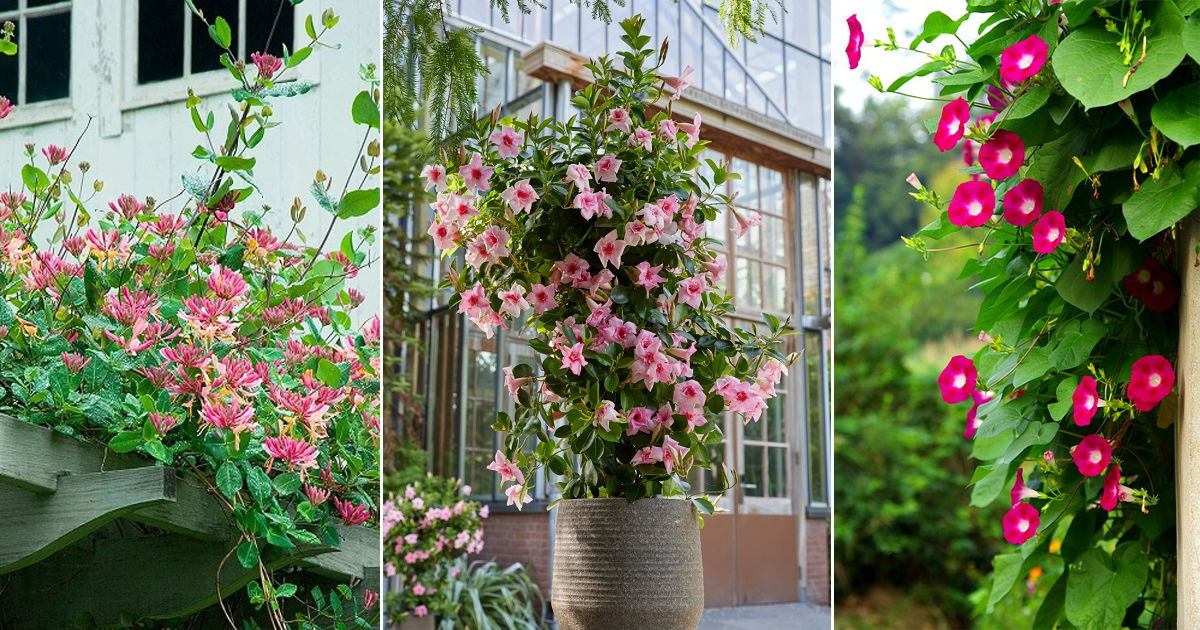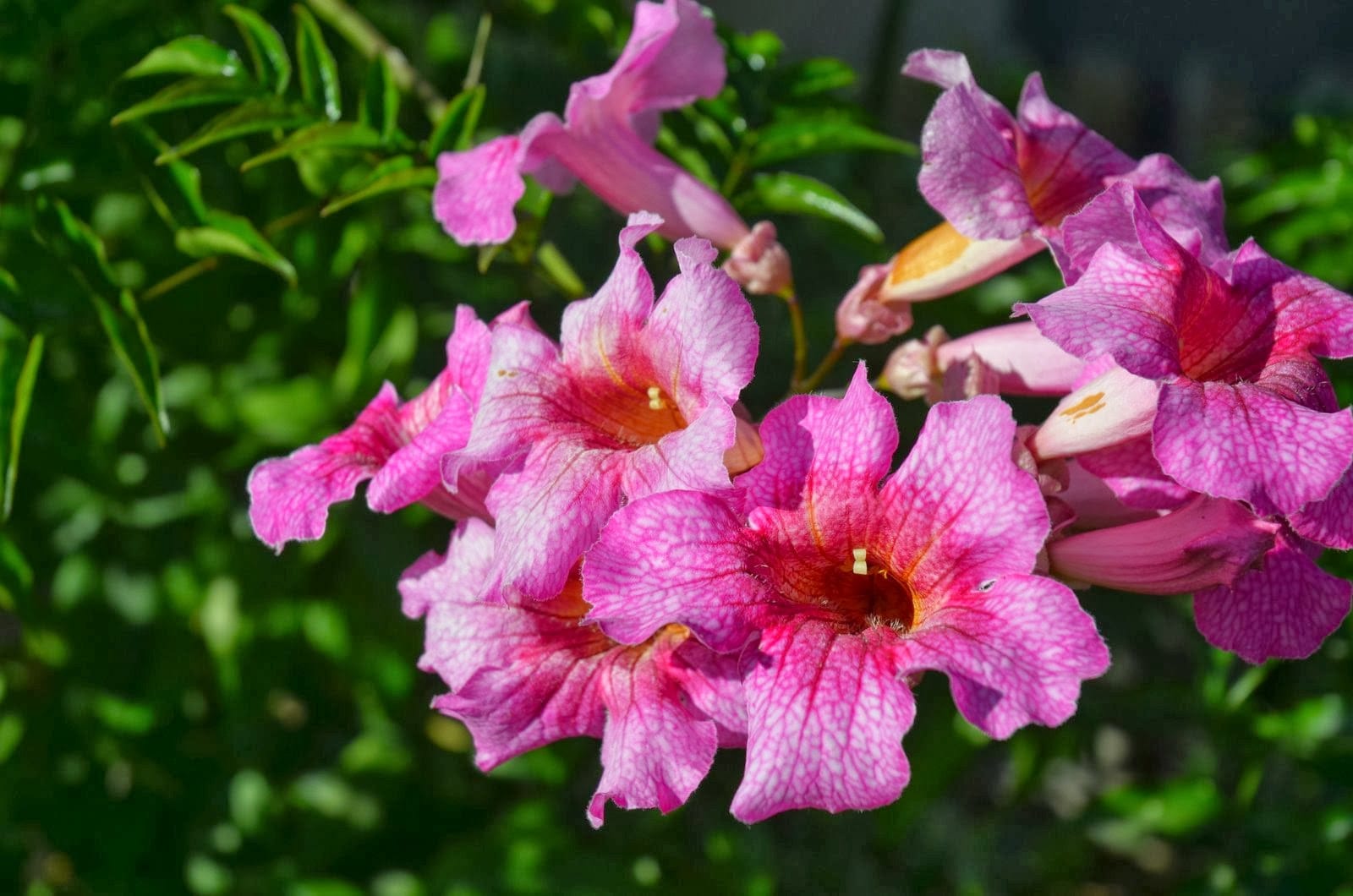What is a Trumpet Vine and How to Identify it
The Trumpet Vine, also known as Campsis radicans, is a vigorous and fast-growing vine native to North America. It is renowned for its showy, trumpet-shaped flowers that bloom in shades of pink, orange, and red. The vine’s distinctive features include its compound leaves, which are composed of 7-11 leaflets, and its ability to grow up to 40 feet tall. To identify a Trumpet Vine, look for its woody stems, which are often covered in a thick, brown bark, and its clusters of flowers that bloom in late summer.
Trumpet Vines are often confused with other types of vines, such as the Honeysuckle or the Clematis. However, the Trumpet Vine’s unique combination of compound leaves and showy, trumpet-shaped flowers makes it easily distinguishable. Additionally, the vine’s growth habits, which include its ability to climb up trees, walls, and other structures, make it a popular choice for gardeners and landscapers.
In terms of its growth habits, the Trumpet Vine is a deciduous vine that thrives in full sun to partial shade. It prefers well-drained soil and can tolerate a range of soil types, from acidic to alkaline. The vine is also relatively low maintenance, requiring only occasional pruning to keep it under control.
For gardeners looking to add a touch of elegance to their garden or landscape, the Trumpet Vine is an excellent choice. Its showy flowers and vigorous growth habits make it a popular choice for trellises, arbors, and other garden structures. Additionally, the vine’s ability to attract hummingbirds and other pollinators makes it a great choice for gardeners looking to create a wildlife-friendly garden.
When it comes to incorporating the Trumpet Vine into your garden or landscape, there are a few things to keep in mind. First, make sure to provide the vine with a sturdy structure to climb on, such as a trellis or arbor. Second, be sure to plant the vine in well-drained soil and provide it with full sun to partial shade. Finally, be prepared to prune the vine regularly to keep it under control and encourage optimal flowering.
How to Grow and Care for a Trumpet Vine with Pink Flowers
Trumpet Vines with pink flowers are relatively low maintenance and easy to care for, making them a great choice for gardeners of all skill levels. To grow a healthy and thriving Trumpet Vine, it’s essential to provide it with the right conditions. Here are some tips and advice on how to grow and care for a Trumpet Vine with pink flowers:
Soil Requirements: Trumpet Vines prefer well-drained soil that is rich in organic matter. They can thrive in a wide range of soil types, from acidic to alkaline, but the ideal pH range is between 6.0 and 7.0. To improve soil fertility, add a balanced fertilizer in the spring and summer months.
Sunlight Needs: Trumpet Vines require full sun to partial shade to produce plenty of flowers. Choose a location that receives at least 6 hours of direct sunlight per day. However, in warmer climates, it’s essential to provide some shade to prevent scorching.
Watering: Trumpet Vines are drought-tolerant, but they will perform better with regular watering. Water the vine deeply once or twice a week, depending on weather conditions. Avoid overwatering, which can lead to root rot and other problems.
Pruning: Pruning is essential to maintain the shape and size of the Trumpet Vine. Prune the vine in late winter or early spring, removing any dead or damaged stems. Cut back the stems to about 12 inches from the ground to encourage new growth and promote flowering.
Support: Trumpet Vines are climbing plants that require support to grow upwards. Provide a sturdy trellis or arbor for the vine to climb on. You can also use a fence or a wall to support the vine.
Pest and Disease Control: Keep an eye out for pests and diseases that can affect Trumpet Vines, such as aphids, whiteflies, and root rot. Use organic or integrated pest management methods to control any infestations or infections.
By following these tips and advice, you can grow a healthy and thriving Trumpet Vine with pink flowers. With proper care and attention, this beautiful vine can provide years of enjoyment and elegance to your garden or landscape.
The Meaning and Symbolism of Pink Trumpet Flowers
Pink trumpet flowers, like those found on the Trumpet Vine, have a rich history of symbolism and meaning. In the language of flowers, pink trumpet flowers are often associated with love, passion, and energy. They are also seen as a symbol of elegance and sophistication, making them a popular choice for weddings, anniversaries, and other special occasions.
In addition to their romantic connotations, pink trumpet flowers are also associated with creativity, inspiration, and joy. They are said to represent the beauty and wonder of life, and are often used in floral arrangements and designs to add a touch of whimsy and playfulness.
The symbolism of pink trumpet flowers is also closely tied to their appearance. The trumpet-shaped blooms are said to represent the call of love, while the pink color represents the passion and energy of the heart. The delicate, almost fragile appearance of the flowers is also seen as a symbol of vulnerability and sensitivity.
In terms of their use in garden design and landscaping, pink trumpet flowers can add a touch of elegance and sophistication to any garden or arrangement. They are often used in combination with other flowers and plants to create a sense of drama and flair, and can be used to add a pop of color and interest to even the most mundane garden bed.
One of the most beautiful things about pink trumpet flowers is their ability to add a sense of movement and energy to a garden or arrangement. The delicate, trumpet-shaped blooms seem to dance in the breeze, creating a sense of life and vitality that is hard to resist.
Whether you’re looking to add a touch of romance and elegance to your garden, or simply want to create a beautiful and eye-catching floral arrangement, pink trumpet flowers are a great choice. With their rich symbolism and meaning, they are sure to add a sense of depth and complexity to any garden or design.
Using Trumpet Vines in Garden Design and Landscaping
Trumpet Vines are a versatile and attractive addition to any garden or landscape. With their vibrant pink trumpet-shaped flowers and ability to thrive in a variety of conditions, they can be used in a range of creative and elegant ways.
One of the most popular ways to use Trumpet Vines is as a climbing vine. They can be trained to climb up trellises, arbors, or other supports, creating a stunning display of flowers and foliage. This is a great way to add a touch of elegance and sophistication to a garden or landscape, and can be especially effective in small spaces or containers.
Trumpet Vines can also be used as a groundcover, spreading quickly to fill in gaps and create a lush, verdant carpet. This is a great way to add a pop of color and interest to a garden bed, and can be especially effective in areas with poor soil or difficult growing conditions.
In addition to their use as a climbing vine or groundcover, Trumpet Vines can also be used in container gardens. They thrive in containers, and can be trained to spill over the edges or climb up supports. This is a great way to add a touch of elegance and sophistication to a patio or balcony, and can be especially effective in small spaces.
When using Trumpet Vines in garden design and landscaping, it’s essential to consider their growth habits and requirements. They prefer well-drained soil and full sun to partial shade, and can be sensitive to extreme temperatures and weather conditions. However, with proper care and attention, they can thrive in a range of conditions and provide a stunning display of flowers and foliage.
Some popular garden styles and themes that incorporate Trumpet Vines include:
Cottage gardens: Trumpet Vines are a classic addition to cottage gardens, where they can be trained to climb up trellises or arbors and create a stunning display of flowers and foliage.
Mediterranean gardens: Trumpet Vines thrive in the warm, sunny conditions of Mediterranean gardens, where they can be used as a groundcover or climbing vine.
Container gardens: Trumpet Vines are a great addition to container gardens, where they can be trained to spill over the edges or climb up supports.
By incorporating Trumpet Vines into your garden design and landscaping, you can add a touch of elegance and sophistication to your outdoor space. With their vibrant pink trumpet-shaped flowers and ability to thrive in a variety of conditions, they are a versatile and attractive addition to any garden or landscape.
Pink Trumpet Vine Varieties and Cultivars
There are several popular varieties and cultivars of Trumpet Vines with pink flowers, each with its own unique characteristics, growth habits, and flowering patterns. Here are a few examples:
‘Flava’ is a popular variety of Trumpet Vine that produces bright pink, trumpet-shaped flowers with a yellow throat. It is a vigorous grower that can reach up to 30 feet in height and has a spread of around 10 feet.
‘Rubra’ is another popular variety of Trumpet Vine that produces deep pink, trumpet-shaped flowers with a red throat. It is a slightly more compact grower than ‘Flava’, reaching up to 20 feet in height and having a spread of around 8 feet.
‘Rosea’ is a variety of Trumpet Vine that produces pale pink, trumpet-shaped flowers with a white throat. It is a more delicate grower than ‘Flava’ or ‘Rubra’, reaching up to 15 feet in height and having a spread of around 6 feet.
In addition to these varieties, there are also several cultivars of Trumpet Vine that have been developed for their unique characteristics, such as ‘Madame Galen’ and ‘Trumpet Vine’. These cultivars often have more vibrant or unusual flower colors, and may have different growth habits or flowering patterns than the standard varieties.
When choosing a variety or cultivar of Trumpet Vine, it’s essential to consider the specific growing conditions and needs of the plant. Different varieties and cultivars may have different requirements for sunlight, soil, and watering, so be sure to research the specific needs of the plant you are interested in.
Some popular characteristics of Trumpet Vine varieties and cultivars include:
Flower color: Trumpet Vines come in a range of flower colors, including pink, yellow, orange, and red.
Growth habit: Trumpet Vines can be either climbing or non-climbing, and can range in height from 10 to 30 feet.
Leaf shape and size: Trumpet Vines have compound leaves that can range in size from 4 to 12 inches.
Flowering pattern: Trumpet Vines can produce flowers in a range of patterns, including clusters, spikes, and solitary blooms.
By choosing the right variety or cultivar of Trumpet Vine for your specific needs and growing conditions, you can enjoy the beauty and elegance of these stunning flowers in your garden or landscape.
Trumpet Vine Pests and Diseases: Common Problems and Solutions
Trumpet Vines are generally a hardy and low-maintenance plant, but they can be susceptible to certain pests and diseases. Here are some common problems that can affect Trumpet Vines, along with some solutions:
Aphids: Aphids are small, soft-bodied insects that can feed on the sap of Trumpet Vines. They can cause curled or distorted leaves, and can also transmit plant viruses. To control aphids, use neem oil or insecticidal soap.
Whiteflies: Whiteflies are small, winged insects that can feed on the sap of Trumpet Vines. They can cause yellowing or stunted leaves, and can also transmit plant viruses. To control whiteflies, use yellow sticky traps or insecticidal soap.
Root Rot: Root rot is a fungal disease that can cause the roots of Trumpet Vines to rot. It can be caused by overwatering or poor drainage. To prevent root rot, make sure the soil drains well and avoid overwatering.
Leaf Spot: Leaf spot is a fungal disease that can cause small, circular spots to form on the leaves of Trumpet Vines. It can be caused by high humidity or poor air circulation. To prevent leaf spot, make sure the plants have good air circulation and avoid overhead watering.
Integrated Pest Management (IPM): IPM is a holistic approach to managing pests and diseases. It involves using a combination of techniques, such as cultural controls, biological controls, and chemical controls, to manage pests and diseases. For Trumpet Vines, IPM can include practices such as pruning, watering, and fertilizing, as well as using natural pest control methods like neem oil and insecticidal soap.
Organic Pest Control Methods: Organic pest control methods are a great way to manage pests and diseases on Trumpet Vines without using synthetic chemicals. Some popular organic pest control methods include:
Neem oil: Neem oil is a natural insecticide that can be used to control aphids, whiteflies, and other pests.
Insecticidal soap: Insecticidal soap is a natural insecticide that can be used to control aphids, whiteflies, and other pests.
Pyrethrin: Pyrethrin is a natural insecticide that can be used to control aphids, whiteflies, and other pests.
By using these common pest and disease management techniques, you can keep your Trumpet Vine healthy and thriving.
Propagating Trumpet Vines: Tips and Techniques
Propagating Trumpet Vines is a relatively easy process that can be done through stem cuttings, layering, or seed propagation. Here are some tips and techniques for successful propagation:
Stem Cuttings: Take 4-6 inch stem cuttings from the current season’s growth, making sure each cutting has at least two nodes. Remove lower leaves, dip the cut end in rooting hormone, and plant in a pot filled with a well-draining mix. Keep the soil moist and warm until roots develop.
Layering: Bend a long stem of the Trumpet Vine down to the ground and secure it with a rock or a U-shaped wire. Cover the buried portion with soil and wait for roots to develop. Once roots have formed, cut the stem below the soil line and plant the new rooted section in a pot or in the ground.
Seed Propagation: Sow seeds indoors 6-8 weeks before the last frost date in your area. Keep the soil warm and moist until germination. Transplant seedlings outdoors after the last frost date, spacing them 3-4 feet apart.
Tips for Successful Propagation:
Make clean cuts: When taking stem cuttings, make sure to make clean cuts just above a node using a sharp, sterile knife or pruning tool.
Use rooting hormone: Apply rooting hormone to the cut end of the stem to increase the chances of successful rooting.
Provide adequate moisture: Keep the soil consistently moist during the propagation process, but not waterlogged.
Provide adequate light: Trumpet Vines require bright, indirect light to photosynthesize and grow. Provide supplemental lighting if necessary.
Monitor temperature: Trumpet Vines prefer daytime temperatures between 65-75°F (18-24°C) and nighttime temperatures around 55-65°F (13-18°C).
By following these tips and techniques, you can successfully propagate Trumpet Vines and enjoy their beautiful pink trumpet-shaped flowers in your garden or indoor space.
Trumpet Vine Arrangements and Floral Designs
Trumpet Vines with pink flowers are a popular choice for floral arrangements and designs due to their unique and elegant appearance. Here are some ideas for using Trumpet Vines in creative and elegant ways:
Bouquets: Trumpet Vines can be used to create stunning bouquets that are perfect for weddings, anniversaries, and other special occasions. Simply combine the Trumpet Vine flowers with other flowers and foliage, such as roses, peonies, and eucalyptus, and arrange them in a vase or container.
Centerpieces: Trumpet Vines can be used to create beautiful centerpieces for tables and other surfaces. Simply arrange the Trumpet Vine flowers in a vase or container, and add some decorative elements, such as candles, pebbles, or shells, to create a unique and elegant design.
Wreaths: Trumpet Vines can be used to create stunning wreaths that are perfect for doors, walls, and other surfaces. Simply arrange the Trumpet Vine flowers and foliage in a circular pattern, and add some decorative elements, such as ribbons, bows, or pinecones, to create a unique and elegant design.
Garlands: Trumpet Vines can be used to create beautiful garlands that are perfect for decorating stairs, mantels, and other surfaces. Simply arrange the Trumpet Vine flowers and foliage in a linear pattern, and add some decorative elements, such as ribbons, bows, or pinecones, to create a unique and elegant design.
Trumpet Vine arrangements and floral designs can add a touch of elegance and sophistication to any room or space. With their unique and beautiful appearance, they are sure to impress and delight anyone who sees them.
Some popular flowers and foliage that can be used in combination with Trumpet Vines include:
Roses: Roses are a classic choice for floral arrangements and designs, and they pair perfectly with Trumpet Vines.
Peonies: Peonies are a popular choice for floral arrangements and designs, and they add a touch of elegance and sophistication to any design.
Eucalyptus: Eucalyptus is a popular choice for floral arrangements and designs, and it adds a fresh and citrusy scent to any design.
By combining Trumpet Vines with other flowers and foliage, you can create unique and elegant arrangements and designs that are sure to impress and delight anyone who sees them.



